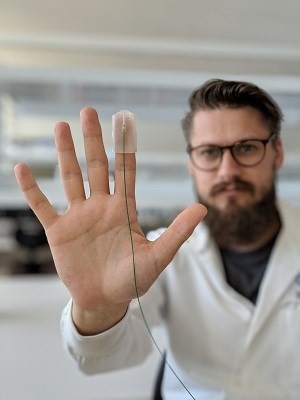Mar 13 2019
The world’s first wearable probe, recently developed by researchers, improves the sense of touch by imaging and subsequently measuring the elasticity and stiffness of biological tissues.
 A new wearable probe enhances the sense of touch by imaging and quantifying the stiffness and elasticity of biological tissue. The device could help improve the surgical removal of breast cancer and other types of cancer. (Image credit: Rowan W. Sanderson, University of Western Australia)
A new wearable probe enhances the sense of touch by imaging and quantifying the stiffness and elasticity of biological tissue. The device could help improve the surgical removal of breast cancer and other types of cancer. (Image credit: Rowan W. Sanderson, University of Western Australia)
The development of this innovative device is now ongoing to enhance the surgical excision of breast cancer and may even prove valuable for liver and brain surgery and other forms of cancer.
Scientists from the University of Western Australia (UWA) have explained the novel device in The Optical Society (OSA) journal, Biomedical Optics Express. Within the device, a fiber probe is integrated into a wearable thimble.
Breast-conserving surgery is known to be the most standard surgical procedure for treating breast cancer. During this surgery, surgeons tend to touch and compress the tissue in order to make sure if the stiffer cancerous tissue has been taken out. Following this, histopathological testing is carried out after some days to confirm whether the entire tumor was removed or not.
However, at present, 20% to 30% of patients subjected to this kind of operation need another surgical procedure because the histopathological tests still reveal the presence of cancerous cells.
Our new probe aims to enhance the surgeon’s subjective sense of touch through quantified, high-resolution imaging of tissue stiffness. This could make it easier to detect and remove all the cancerous tissue during the first breast conserving surgery, which would reduce the physical and psychological burden and cost that accompanies re-excision.
Rowan W. Sanderson, Study First Author, University of Western Australia.
Turning touch into images
The finger-mounted optical probe employs a method known as quantitative micro-elastography, or QME for short, to convert the sense of touch into high-resolution images. The QME technique utilizes measurements from an optical imaging method, referred to as optical coherence tomography (OCT), which produces depth-resolved, high-resolution images of tissue structure by quantifying light’s reflections, or “echoes.”
In order to utilize this novel device, the finger-mounted optical probe is perpendicularly pressed into the tissue and, at the same time, OCT images are recorded.
“By preserving the sense of touch, we aim to conserve the existing clinical workflow and increase the likelihood that this technology would be adopted for wider clinical use,” informed Sanderson.
To measure the elasticity accurately, the investigators created unique signal processing techniques with custom algorithms to tackle unpredictable pressure and motion at the time of scanning. With the help of 3D printing, the team was able to rapidly create models of the outer casing of the probe in an easy and economical way.
“Our finger-mounted probe can accurately detect microscale changes in stiffness, which are indicative of disease,” Sanderson said. “The small size makes it ideal for imaging in confined spaces such as a surgical cavity.”
Tissue tests
In order to verify the probe, the researchers tested it on materials, called silicone phantoms, developed to imitate both diseased and healthy tissues in the breast. Such tests demonstrated that the finger-mounted optical probe had as much as 87% accuracy, which was somewhat lower than a traditional benchtop QME system, but still adequately high for promising clinical use.
The researchers later applied the optical probe to determine the variation in stiffness induced by heating a specimen of kangaroo muscle. Through this experiment, it became evident that the muscle sample experienced increased stiffness by as much as 6 fold after the heating process.
Upon scanning the probe laterally over a silicone phantom comprising of a rigid inclusion, a preliminary 2D image was achieved. While this approach demonstrated lower precision when compared to the experiment conducted without scanning, the prospect for imaging by swiping the finger of the operator is quite encouraging, stated the researchers.
The contrast between sample features was still evident, which indicates that 2D scanning holds a lot of promise going forward.
Rowan W. Sanderson, Study First Author, University of Western Australia.
At present, the team is working to integrate the probe’s optical components into a surgical glove that would maintain the touch dexterity and sensitivity of manual palpation. The researchers are also enhancing the precision of the 2D scanning.
The study forms part of a wider project to devise innovative tools to enhance surgery. Both handheld and bench-top implementations of micro-elastography have also been developed by the researchers.
Apart from efforts within the University of Western Australia, the researchers also work closely with a UWA start-up company OncoRes Medical¸ which was established in late 2016 with an aim to commercialize the novel micro-elastography technology.